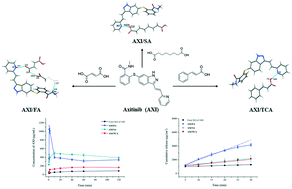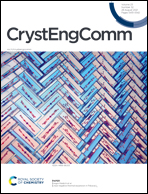Cocrystallization of axitinib with carboxylic acids: preparation, crystal structures and dissolution behavior†
Abstract
Axitinib (AXI) is an oral selective tyrosine kinase inhibitor used for the treatment of early to advanced renal cell carcinoma. However, the clinical efficacy of AXI is severely limited by low oral bioavailability due to its poor aqueous solubility. Although AXI was found to demonstrate six polymorphs, at least 66 solvates and some salts, cocrystals of AXI have not been reported up to the present. To improve its aqueous solubility, cocrystallization of AXI with a group of carboxylic acids was attempted in the present work. Finally, one salt cocrystal with fumaric acid and two molecular cocrystals with suberic acid and trans-cinnamic acid were successfully prepared by liquid assisted grinding and slurry methods. The newly obtained cocrystals were characterized by single crystal and powder X-ray diffraction, thermal analysis, proton nuclear magnetic resonance and Fourier transform infrared spectroscopy and were subjected to powder and intrinsic dissolution experiments, dynamic vapor sorption studies and stability tests. In comparison to pure AXI, all of the cocrystals show a significantly improved apparent solubility and dissolution rate without compromising the physical stability of the drug. These findings suggest that the cocrystals herein could be used as promising solid forms of AXI for the development of its more effective oral formulations.

- This article is part of the themed collection: Crystal Engineering Techniques


 Please wait while we load your content...
Please wait while we load your content...